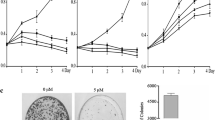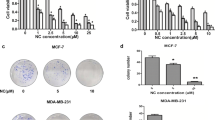Abstract
To investigate the mechanism of the anti-tumor activity of cinobufacini on the breast cancer cell line T-47D, the inhibitory effect of cinobufacini on the proliferation of T-47D was detected via MTT assay and the morphological changes of T-47D and HBL-100 cells caused by cinobufacini were observed with an inverted microscope. Cell apoptosis and cell cycle stages were detected by flow cytometry analysis. The effects of cinobufacini on the expression of active-form and pro-form of caspase-3 were assessed by Western blot analysis. Cinobufacini dramatically inhibited T-47D proliferation in a dose- and time-dependent manner. We found that more than 20% of T-47D cells were killed after treatment with 20 mg/mL cinobufacini for 24 h in vitro. After 6 d of treatment with 20 mg/mL cinobufacini, the cell survival rate decreased by more than 40%. Flow cytometric analysis demonstrated that cinobufacini induced significant apoptosis and changes of the cell cycle distribution of T-47D cells. We used breast cell line HBL-100 as the control, the above experiments except cell cycle analysis showed that cinobufacini more obviously induced the apoptosis of T-47D cells than that of HBL-100 cells. Western blot analysis confirmed the protein expression of active caspase-3 increased with increasing the dose of cinobufacini. These results indicate that cinobufacini induces the apoptosis of T-47D cells via the up-regulation of caspase-3.
Similar content being viewed by others
References
Huang Y. Z., Chen W. Q., Wu C. X., Zheng S. R., Chen J. G., Cheng L. P., Wang N., Zhang S. W., Zheng Y., Tumor, 2012, 8, 605
Siegel R., Naishadham D., Jemal A., CA Cancer J. Clin., 2012, 62(1), 10
Robert W., Carlson D., Craig A., Benjamin O. A., National Comprehensive Cancer Network, 2012, http://www.nccn.org./index.asp
Zhu X. Y., Meng Z. Q., Chen Z., Yu P. Z., Ge Y. Q., Liu L. M., Chemistry Online, 2007, 10, 797
Zhang Y., Tang X., Liu X. L., Li F., Lin X., Analytica Chimica Acta, 2008, 610(2), 224
Zhang Z. Y., Zhang C. H., Wang C. W., Zhu J. Q. Zhu Z. H., Huang D. Q., Traditional Chinese Drugs Research and Clinical Pharmacology, 1999, 15(5), 28
Qi F., Inagaki Y., Gao B., Cui X. Y., Xu H. L., Kokudo N., Li A. Y., Tang W., Cancer Sci., 2011, 102(5), 951
Qi F., Lia A., Zhao L., Xu H. L., Inagaki Y., Wang D. L., Cui X. Y., Gao B., Kokudo N., Nakata M., Tang W., J. Ethnopharmacol, 2010, 128(3), 654
Ma L., Song B., Jin H., Pi J., Liu L., Jiang J. H., Cai J. Y., Bioorg. Med. Chem. Lett., 2012, 22(3), 1459
Yin W. J., Liu G. Y., Di G. H., Wu J., Lu J. S., Han Q. X., Shen Z. Y., Liu L. M., Shao Z. M., Tumor, 2009, 29(7), 641
Lee D. Y., Yasuda M., Yamamoto T., Yoshida T., Kuroiwa Y., Life Sci., 1997, 60(2), 127
Sheng X. S., Xui L. J., Journal of Practical Oncology, 2007, 1, 32
Piao B. G., Li X., Sun L. L., Kan S. F., Liu L., Huang H. Y., Yang G. H., Wang Y. H., Sun J. H., Piao Y. F., Jin N. Y., Chem. Res. Chinese Universities, 2011, 27(3), 455
Xie R. F., Li Z. C., Gao B., Shi Z. N., Zhou X., J. Ethnopharmacol, 2012, 141(2), 692
Yin J. Q., Wen L., Wu L. C., Gao Z. H., Huang G., Wang J., Zou C. Y., Tan P. X., Yong B. C., Jia Q., Shen J. N., Toxicol. Lett., 2013, 218(2), 129
Alan G. P. and Reiner U. J., Cell Death and Differentiation, 1999, 6, 99
Elore S., Toxicologic Pathology, 2007, 35, 495
Nagata S., Cell Press, 1997, 88, 355
Li Y., Shen J. T., Gao C., Li Q., Jin Y. H., Chem. Res. Chinese Universities, 2010, 26(5), 792
Yu C. H., Kan S. F., Pu H. F., Jea C. E., Wang P. S., Cancer Sci., 2008, 99(12), 2467
Sun Y., Lu X. X., Liang X. M., Cui X. N., Chinese-German Journal of Clinical Oncology, 2011, 10(1), 27
Jing Y., Ohizumi H., Kawazoe N., Hashimoto S., Masuda Y., Nakajo S., Yoshida T., Kuroiwa Y., Nakaya K., Jpn. J. Cancer Res., 1994, 85(6), 645
Watahe M., Masuda Y., Nakajo S., Yoshida T., Kuroiwa Y., Nakaya K., Biol. Chem., 1996, 271(24), 14067
Efferth T., Davey M., Olbrich A., Rücker G., Gebhart E., Davey R., Blood Cells Mol. Dis., 2002, 28, 160
Author information
Authors and Affiliations
Corresponding author
Additional information
Supported by the National Natural Science Foundation of China(No.30300336).
Rights and permissions
About this article
Cite this article
Wang, W., Shi, A. & Fan, Z. Apoptosis of T-47D cells induced by cinobufacini via a caspase-3-dependent manner. Chem. Res. Chin. Univ. 30, 108–113 (2014). https://doi.org/10.1007/s40242-014-3196-x
Received:
Accepted:
Published:
Issue Date:
DOI: https://doi.org/10.1007/s40242-014-3196-x




